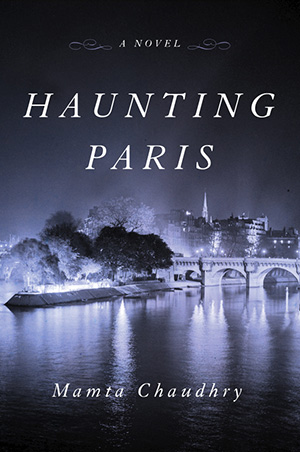Q & A with Mamta Chaudhry, author of Haunting Paris
When an author writes a book proposal, they often invent profiles of prospective readers; the purpose is to help a publisher envision what type of reader might buy that book. When I first heard about Mamta Chaudhry’s forthcoming novel, HAUNTING PARIS, it felt as if my picture should have been used in her book proposal. The book checks off just about every topic I could ask for: Paris? Check. An old, handwritten letter? Check. WWII? Check! A compelling history-mystery? CHECK!
Within minutes of learning about HAUNTING PARIS I pre-ordered a copy. At the time I didn’t know anything about Mamta; in the months since we’ve connected via social media and talked on the phone once, though we have not met in person—yet!
HAUNTING PARIS, published by Nan A. Talese/Doubleday, will be out June 18 and I can’t wait to read it! Because Mamta’s book may appeal to readers who enjoyed MARCEL’S LETTERS, I asked Mamta if I could interview her about her book, her background, and our overlapping interests.
CP: First of all, congratulations on the forthcoming release of HAUNTING PARIS! I would love to know more about your connection to Paris. When did you first visit the city? Why did you decide to set your book there?
MC: Thanks, Carolyn. So happy to be chatting with you. And yes, it’s uncanny how much our interests overlap, both as readers and as writers. Now that I’m well into MARCEL’S LETTERS, I can see the mutual fascinations you mention even more clearly. And as far as plunging into the story of a city not my own, it wasn’t something I had planned. My early novels were set in India and in the US, and they came close but weren’t picked up. But I heard a voice in my head that I found so compelling (the way you were obsessed with Marcel’s letters), that I had to follow wherever it led me. That was Julien’s voice, and the place was Paris, a city I had fallen in love with, like so many others, on my first visit decades ago.
CP: Tell us a bit about Julien, and the voice you heard.
MC: I think it all stems from my love of music. I heard a drift of piano music from a lighted window in Paris. I couldn’t see who was playing, but I had this strong image of a man listening very intently. And that was Julien, drawn back to the woman he loves and a place he called home while he lived. The music was like a summons back to this world, where he had unfinished business, a failed quest for his niece who was swept away without a trace during the dark days of the occupation.
CP: That gave me goosebumps! Did you recognize a specific piece of music in that vision? Is a specific piece of music an important part of your novel?
MC: Yes, it is. Maybe because I was steps away from where Chopin had once played that his Barcarolle suffuses the book. And it’s not just the actual piece of music, but trying to capture in words what music does in its own way, to capture cadences, motifs, rhythms. It’s like trying to talk about painting, as Virginia Woolf does in TO THE LIGHTHOUSE, trying to express one medium through another.
Note: Mamta has assembled a soundtrack of music from HAUNTING PARIS. Listen to Chopin’s Barcarolle and more on her website.
CP: I found that to be a challenge when talking about the beauty and nuance of handwriting, too. A handwritten letter is important to your story; can you talk a bit more about that? Is it the content of the letter that draws readers in? The aesthetic? The fact the letter had been hidden?
MC: There’s something so mysterious, so uncanny, when you come across a secret—a letter in this instance—that is not meant for your eyes, and the only person you can ask about it can no longer speak to you. So what draws Sylvie into Julien’s quest is the urgency to find answers that must have been important to him. And, you won’t believe this, but just like the letter M first attracted you to Marcel’s handwriting, the single initial on the piece of paper she finds is the letter M and she tries to track down this unknown person in a vast city.
CP: You just gave me goosebumps again! Tell me more about Sylvie.
MC: Well, she is the pianist I mentioned and she is extremely tongue-tied and shy . . . but very eloquent in music. One of the things that has always attracted me is to find ordinary people who act with extraordinary courage. And it turned out that Sylvie, of all people, is the one to speak out, the lone voice in the room. So it’s a story about cruelty, as you can imagine, during the Nazi occupation, but also of resistance, of love.
CP: Had you studied the history of Paris during the occupation? Do you have a personal connection? I’m so fascinated how this story came to you!
MC: I wish I were the kind of person who could say I’m going to write this story, I’ll go out and research it, and come back and write a chapter outline, and hey presto, a book! But like you, I always find the least efficient way to get to where I’m going, many detours and dead ends along the way (you see, I’ve been reading your book attentively). So I wrote about these characters, and the better I got to know them, the more I wanted to know about the world they lived in, so the story and the history mutually reinforced each other. I did a lot of research, yes, but then I didn’t want it to sound like research, but part of a lived life. And it was a gift to me that I met people who had actually lived through the horrors I was only imagining and they were able to share their stories with me. Oh, and another thing about me, I am always attracted to the shadows that lie beneath sunlit scenes and beautifully lighted cities.
CP: You made me laugh out loud at the “least efficient way to get where I’m going” comment.
Thanks for the glimpse into your writing process—it is always fascinating to hear how other writers work. It’s amazing you met with people who lived through WWII; did you weave any of those stories into this novel?
MC: Not directly, but details, incidents, professions. It was very hard for many of them to talk about the “dark years,” so I felt an obligation to bring their stories to light. And, given our mutual fascination with handwriting and fonts and the way books look in general, it’s no surprise that some scenes are set in a book bindery. My wonderful agent, Marly Rusoff, was particularly taken with those scenes because that was her father’s profession, and I was so happy I got those details right.
CP: Tell me more about your background. I read you worked in radio, and that you have lived in India and in various places in the U.S. and have spent a lot of time in Europe. How did those experiences add to HAUNTING PARIS?
MC: I was actually a radio announcer and programmer, and I’ve always been drawn to classical music (though I’m not a musician myself, it felt like the next-best thing). So that experience of going out as a disembodied voice that spread across the city was, I suppose, a subliminal inspiration for the ghost in my book. And as for living in various places and traveling widely, it’s like reading voraciously, everything you see and read becomes a part of you, so you are changed by the atmosphere of every place, with its particular concerns. But you also learn that there are some things that hold across all latitudes and longitudes—love, loss, yearning. And that’s what I write about.
CP: Yes: love, loss, yearning. The universal truths.

Switching gears slightly, I love the atmospheric look of your book cover. The Gothic spire of the extraordinary Sainte-Chapelle is just below the title and makes me think of the day Notre Dame was on fire. That is one of those “I’ll always remember where I was when…” days. What were you doing that day?
MC: That day, I was actually catching a flight to Paris—I wrote some fragments about what it felt like to be over the Atlantic, not knowing if anything would be left of the cathedral when we landed. And then the aftermath of the fire, the Good Friday and Easter crowds both mourning and celebrating. But as for the cover, I’m so glad you like it. Emily Mahon designed it and for me it captures the feel of the book so perfectly, the river, the bridge, the spire. Sainte-Chapelle and Pont Neuf are not the exact physical location of the main story, but mentioned in the book. She obviously read the book closely, as every good cover designer does, I imagine, and took a black-and-white photograph and suffused it with that beautiful color, reflecting the blue hour, the hour between dog and wolf as the French call it, which is essential to the feeling of the book.
CP: She certainly captured the mood of “shadows that lie beneath sunlit scenes and beautifully lighted cities.”
I was delighted to hear you will be coming to Minnesota to take part in Literature Lovers’ Night Out, which is a series of meet-the-author events sponsored by Excelsior Bay Books. I look forward to meeting you in real life! Have you been to Minnesota before?
MC: Never. Pamela Klinger-Horn, who is such a champion of authors, both new and established, read HAUNTING PARIS before it was even a bound galley and immediately asked my publisher to send me to Minnesota. A month or two ago, she said the way things were going, I might need snow boots. In June! Whatever footwear I need to buy, I am thrilled to be coming. And however cold the temperatures, I know from dealing with her, with you, and other Minnesotans, that you are among the warmest people anywhere.
CP: That’s very sweet of you to say. If it’s any comfort, next week is supposed to be in the 80s, so snow boots aren’t necessary—on this trip, anyway!
If you want to meet Mamta (along with authors Nickolas Butler, Bridgett M. Davis and Renee Rosen), mark your calendar for Monday, June 24 and/or Tuesday June 25. On Monday, from 7:00-9:00 pm, Literature Lovers’ Night Out will be in Excelsior at the Shorewood Community Center (buy tickets here), and on Tuesday, from 7:00-8:30 pm, Literature Lovers’ Night Out will be in Stillwater at Community Thread (buy tickets here).
HAUNTING PARIS will be released June 18 and can be purchased from IndieBound, Penguin Random House, or anywhere books are sold.
Learn more about Mamta at www.mamtachaudhry.com.
————————
POSTSCRIPT: June 27, 2019
————————
It was such a delight meeting Mamta at Literature Lovers’ Night Out earlier this week. I should note ALL FOUR of the authors featured at the event—Nickolas Butler, Bridgett M. Davis, Renee Rosen, and Mamta—were delightful, but I’ll also confess it was a special delight to meet Mamta. I felt like a total fangirl! ‘Haunting Paris’ is amazing; it is every bit as beautiful and compelling as I had hoped. In fact, I will likely read it again someday—and reading books multiple times is something I rarely do.


